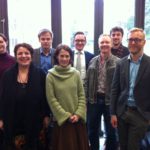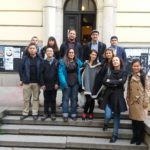On June 06, 2018, the Nomadic Empires team welcomed Professor Beatrice Manz (Tufts University, USA), who specializes on history of the Mongol and the Timurid Empires, and Professor David Morgan (SOAS and formerly University of Wisconsin-Madison, USA)—a historian of the Mongols and the medieval Middle East. Professor Manz presented a workshop titled: Tribes, Armies and Empires: Social Morphology of Pastoral Nomads in the Mongol and Timurid Periods, where she addressed the changing structure of nomadic social groups from the rise of the Mongol Empire to the Timurid Period. The workshop focused in particular on the theme of nomadic, tribal, and mixed armies, and their creation, development, and dispersion during different historical cases and phases of centralized rulership and its collapse. Professor Manz first examined the creation of Chinggis Khan’s army, then she traced the trajectories of such tribal groups as the Jalayirids and the Oirats during the Ilkhanid Period, and the subsequent restructuring of armies during the Timurid Period, when Timur implemented his strategy of suppressing tribal power.
The workshop participants had a detailed discussion about current terminology with regard to nomadic social morphologies (such as tribes, clans, lineages, armies, empires, etc.), their genesis and strategies of affiliation, leadership, and endurance (kinship, marriage alliances, hereditary offices and positions, incorporation and diversity, personal followings, forced displacements, etc). In the afternoon, discussion continued about the varieties of armies employed and engaged by nomadic empires. The focus was on the issues of logistics, provisions, demographics, geographies of incorporation and dispersion of tribal and non-tribal contingents of these armies, as well as the role and participation of women in wars waged by nomadic empires.
 Dr. Paul Wordsworth (Oriental Studies, University of Oxford) placed the communities of these frontiers under the microscope through a presentation of his own fieldwork on major trade centers, namely Merv, the geographic itineraries of cross-desert pathways to reach them, and the constructed landscapes of those routes as more than mere caravanserais.
Dr. Paul Wordsworth (Oriental Studies, University of Oxford) placed the communities of these frontiers under the microscope through a presentation of his own fieldwork on major trade centers, namely Merv, the geographic itineraries of cross-desert pathways to reach them, and the constructed landscapes of those routes as more than mere caravanserais.